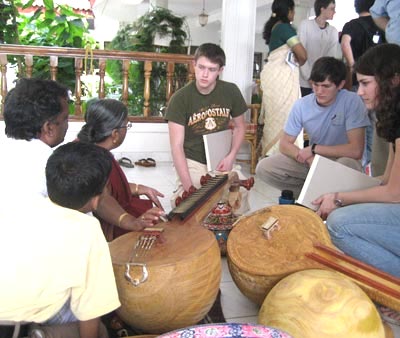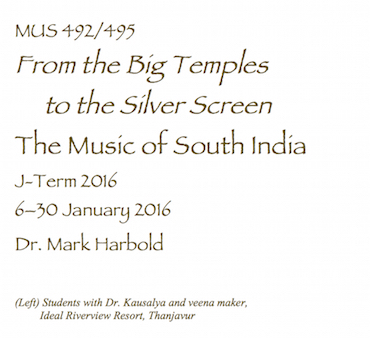

 |
 |
From the Big Temples to the Silver Screen
| ||
|
|
|
|
|
|
|
|
| Download a printer-friendly version of the syllabus | ||
|
Typical Course Activities Shopping in Tambaram – Traditional meal on banana leaves – Kolatta Javandharai ritual at Kaveri River | ||
|
COURSE DESCRIPTION |
|
From the Big Temples to the Silver Screen—The Music of South India |
|
Classes at Madras Christian College—Chennai Students with Sri Ghatam Karthick & percussionists – Our yoga master – Dr. Harbold thanks Dr. Sunder & musicians | ||
|
COURSE GOALS |
|
This course will help you to:
|
|
Course Activities at Madras Christian College—Chennai Walking tour of MCC – Bull horns painted for Pongal festival – Dessert! Dr. Kingsley chops sugarcane | ||
|
COURSE EVALUATION |
|
Grades will be assigned based on the following:
|
|
At the Beach Resort—Mamallapuram (Mahabalipuram) Ideal Resort welcome ritual – Group hike to Tiger Cave – With Dr. Suri at Pancha Rathas | ||
|
REQUIRED READINGS |
| It’s an excellent idea to do your primary and supplemental readings before we leave on January 6th—why miss India by sitting in your room reading? While in India, I also expect you to regularly read one of the English-language Indian daily newspapers. |
|
PRIMARY TEXTBOOKS
|
|
SUPPLEMENTAL READINGS
|
|
SUPPLEMENTAL READING LIST INDIAN MUSIC
INDIAN ART & ARCHITECTURE
|
|
On the Road to Historic Sites Carrying goods to market in Tiruvaiyaru – At the Thanjavur train station – Street scene in Chennai | ||
| Page created 28 September 2014 by Mark Harbold—last updated 29 October 2015. |